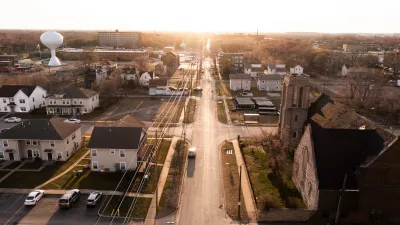The D.C. transit agency plans to increase service in the hopes of boosting lagging ridership and avoiding layoffs and service disruptions.

The Washington Metro announced plans for “a return to normalcy” with its draft budget, reports Justin George for the Washington Post. The agency plans to make improvements to train service while raising fares an average of 5 percent, with fare discounts for income-qualified riders.
“Transit officials say the $2.3 billion budget plan responds to trends that have emerged during the pandemic, but acknowledge the relatively rosy financial forecast will be short-lived without substantial growth in rail ridership.” According to George, “The spending plan avoids layoffs or significant service reductions with the help of federal infrastructure money that transit officials say can insulate Metro — for at least one year — from a harsh landscape for public transit.”
As part of the plan, the Yellow Line would stop operating north of Mount Vernon Square while service frequency would improve on other lines. The agency also plans to reinstate automated piloting, which it stopped using after a fatal 2009 collision. The autopilot system was later found not to have contributed to the crash. “If Metro receives permission from the Washington Metrorail Safety Commission, which monitors safety on the rail system, Metro plans to launch autopilot on the Red Line in spring with a goal of converting the entire system by the end of the year.”
FULL STORY: Metro proposes fare, service hikes while emerging from pandemic

Alabama: Trump Terminates Settlements for Black Communities Harmed By Raw Sewage
Trump deemed the landmark civil rights agreement “illegal DEI and environmental justice policy.”

Planetizen Federal Action Tracker
A weekly monitor of how Trump’s orders and actions are impacting planners and planning in America.

The 120 Year Old Tiny Home Villages That Sheltered San Francisco’s Earthquake Refugees
More than a century ago, San Francisco mobilized to house thousands of residents displaced by the 1906 earthquake. Could their strategy offer a model for the present?

In Both Crashes and Crime, Public Transportation is Far Safer than Driving
Contrary to popular assumptions, public transportation has far lower crash and crime rates than automobile travel. For safer communities, improve and encourage transit travel.

Report: Zoning Reforms Should Complement Nashville’s Ambitious Transit Plan
Without reform, restrictive zoning codes will limit the impact of the city’s planned transit expansion and could exclude some of the residents who depend on transit the most.

Judge Orders Release of Frozen IRA, IIJA Funding
The decision is a victory for environmental groups who charged that freezing funds for critical infrastructure and disaster response programs caused “real and irreparable harm” to communities.
Urban Design for Planners 1: Software Tools
This six-course series explores essential urban design concepts using open source software and equips planners with the tools they need to participate fully in the urban design process.
Planning for Universal Design
Learn the tools for implementing Universal Design in planning regulations.
Clanton & Associates, Inc.
Jessamine County Fiscal Court
Institute for Housing and Urban Development Studies (IHS)
City of Grandview
Harvard GSD Executive Education
Toledo-Lucas County Plan Commissions
Salt Lake City
NYU Wagner Graduate School of Public Service





























